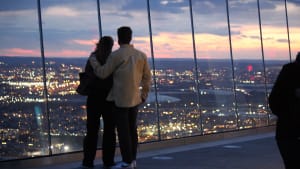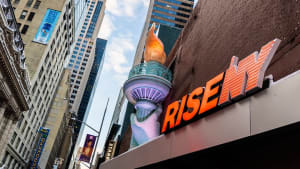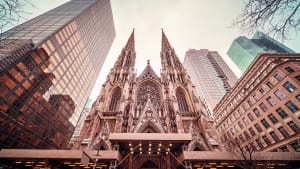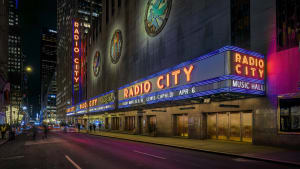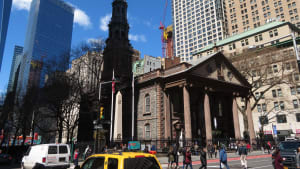Brooklyn Bridge
The Brooklyn Bridge isn’t just a pathway between Manhattan and Brooklyn; it's a historic landmark that has stood the test of time, offering breathtaking views and a rich narrative. Built in 1883, this marvel of engineering was the first to use steel for cable wire and, during its time, was the longest suspension bridge in the world.
The Brooklyn Bridge in a nutshell…
The Brooklyn Bridge stands as an enduring symbol of innovation and resilience, connecting not just two boroughs but also embodying the spirit of New York City itself.
Location: Spans the East River, connecting Lower Manhattan at City Hall to Brooklyn Heights.
Transportation: Accessible by multiple subway lines, including the 4, 5, 6 at Brooklyn Bridge/City Hall in Manhattan and A, C at High Street in Brooklyn. Biking and walking across the bridge are highly recommended for the full experience.
Tickets: No tickets are required to walk across the Brooklyn Bridge; it is free and open to the public.
Visiting Hours: Open 24/7, with scenic views available day and night. Early morning or late evening are best for avoiding crowds and experiencing the bridge’s romantic ambiance.
Imagine walking across the same path that has connected Manhattan to Brooklyn since 1883. The Brooklyn Bridge, a pioneering marvel of its time, initially served as the sole thread between these two bustling boroughs. This iconic structure was crafted under the innovative guidance of John August Roebling and, upon his untimely death, the legacy was carried on by his son, Washington Roebling, with significant help from Emily Warren Roebling. The construction faced numerous challenges and saw the loss of 27 workers, yet it stood strong, symbolizing possibility and resilience. On its opening day, led by Emily herself, the bridge saw over 150,300 pedestrians, setting a precedent for the millions who would follow.
The Brooklyn Bridge was an architectural and financial feat, costing over $19 million in the late 1800s, equivalent to approximately $320 million today. Despite early rumors questioning its stability, the bridge robustly disproved naysayers when P.T. Barnum paraded 21 elephants across in 1884. Now, it sees daily crossings by around 120,000 cars, 4,000 pedestrians, and 2,600 cyclists, making it one of New York’s most frequented landmarks.
Practical Information
Visiting the Brooklyn Bridge is more than just a crossing; it’s an experience enriched with history and stunning views.
Location
Strategically positioned, the Brooklyn Bridge stretches over the East River, connecting Lower Manhattan at City Hall to Brooklyn Heights. Easily accessible from several key points in the city, it remains a focal point for both practical travel and leisure visits.
How to Get There
Whether you’re coming from Manhattan or Brooklyn, there are several convenient options for reaching this iconic landmark. You can take the subway, bus, or bicycle, or even walk, making it easy to include the Brooklyn Bridge in your New York itinerary.
From Manhattan
For those starting on the Manhattan side, the bridge is easily accessible via subway lines 4, 5, or 6 at the Brooklyn Bridge/City Hall Station. Alternatively, the J and Z trains to Chambers Street are also nearby, placing you just a short walk from the pedestrian entrance to the bridge.
From Brooklyn
If you’re coming from Brooklyn, take the A or C train to High Street and follow the exit signs to the park. From there, a scenic walk through the park leads directly to the entrance of the bridge.
Bicycle
Exploring the bridge by bike offers a unique perspective and can be an exhilarating experience. Bike rentals and guided tours are available for those interested in a more dynamic way to cross.
Hop-on Hop-off Buses
Utilizing hop-on hop-off buses can be a great way to see the Brooklyn Bridge along with other major NYC attractions, providing flexibility and ease as you explore the city.
Driving
While driving across the bridge is possible, it is less recommended due to heavy traffic. Walking or biking offers a more intimate and leisurely experience.
Tickets
There is no fee to walk across the Brooklyn Bridge, making it an accessible option for everyone looking to soak in a piece of New York City history.
Enjoying the Brooklyn Bridge with Discount Passes
For those looking to dive deeper into the history and significance of the Brooklyn Bridge, consider using one of these New York tourist passes.
These passes offer access to a variety of Brooklyn Bridge tours, both walking and biking, providing an economical way to enjoy the bridge’s splendor.
The New York Sightseeing Pass
With options like the New York Sightseeing Day Pass, visitors can access nearly all major NYC attractions, including special guided tours of the Brooklyn Bridge.
GoCity Explorer Pass
The Go New York Explorer Pass allows for a flexible approach, letting you choose from over 90 top attractions, including bicycle tours across the Brooklyn Bridge.
The New York Pass
Ideal for culture and history enthusiasts, the New York Pass opens doors to over 100 city attractions, enhancing your visit to the Brooklyn Bridge and beyond.
Visiting Hours
The Brooklyn Bridge is open 24/7, welcoming visitors at any time. For a less crowded experience, consider an early morning or sunset walk—both provide stunning views of the city while avoiding peak times.
Best Time to Visit
To fully appreciate the architectural beauty and panoramic vistas without the crowds, sunrise and sunset are ideal times for a walk on the bridge. The lighting during these times also provides perfect photo opportunities, capturing the city in its best light.
Tours and Experiences on the Brooklyn Bridge
Exploring the Brooklyn Bridge is not just about crossing from one borough to another; it’s about discovering a landmark rich in history and stunning views. Various tours are available, each offering a unique perspective and insight into this iconic structure.
Walking Tour in Manhattan, Brooklyn Bridge, and Waterfront
Join Scott, a 30-year Brooklyn resident, on a 3-hour walking tour that covers 3 miles of historical and picturesque sites. This small group tour ensures personalized attention as you explore key locations and learn about the borough’s evolution, famous residents, and notable film locations. The tour concludes in DUMBO, a hotbed of culture and cuisine, where you’re encouraged to enjoy a leisurely lunch and maybe even find a vintage souvenir at the Brooklyn Flea.
Guided Bike Tour of Lower Manhattan and Brooklyn Bridge
Cycle your way through the highlights of Lower Manhattan and over the Brooklyn Bridge with this guided bike tour. Start at the southern tip of Manhattan and make your way across the iconic bridge, enjoying breathtaking views and prime photo opportunities. This tour is perfect for those looking to cover a lot of ground while learning about the city’s rich history.
NYC Brooklyn Bridge and DUMBO Food Tour
Indulge in Brooklyn’s renowned food scene with this walking tour through DUMBO and across the Brooklyn Bridge. This small-group tour allows you to sample a variety of local flavors, from artisanal bites to traditional Middle Eastern dishes. Discover hidden culinary gems and learn about the neighborhood’s food culture, making this a must-do for any foodie visiting New York.
Brooklyn Bridge & DUMBO Neighborhood Tour - from Manhattan to Brooklyn
This comprehensive walking tour takes you from Manhattan, across the Brooklyn Bridge, and into the trendy DUMBO neighborhood. Learn about the history of the bridge and the surrounding areas from your knowledgeable guide as you enjoy stunning views of iconic Manhattan landmarks. This tour combines cultural enrichment with physical activity, making it a perfect blend for adventure seekers.
Private Brooklyn Bridge Tour with a Local
For a more intimate and detailed exploration, opt for a private walking tour of the Brooklyn Bridge. Starting in Brooklyn, this tour provides an in-depth look at the bridge’s history and its impact on New York City, all while you enjoy spectacular views of the skyline. Tailored to your interests, this tour is ideal for those passionate about architecture, urban planning, and history.
Tips to Visit The Brooklyn Bridge
Visiting the Brooklyn Bridge is an unforgettable experience, but knowing a few tips can make your visit even more enjoyable:
- Timing: Allow at least 45 minutes to cross the bridge at a leisurely pace. Early morning or sunset are ideal times for fewer crowds and cooler weather.
- Transportation Options: Consider taking the NYC Ferry for a quick and scenic route from Manhattan to Brooklyn, or vice versa.
- Relaxation: Visit Brooklyn Bridge Park for a picnic with spectacular views of the Manhattan skyline.
- Photography: Walking towards Manhattan provides the best views for photographs. The slight slope towards the city makes the walk easier and more scenic.
- Dining Recommendations: In Brooklyn, enjoy a meal at local favorites like Juliana’s for pizza or the urban marketplace at Empire Stores for coffee and sandwiches with a view.
- Safety: Be mindful of the bike lane to avoid accidents, as it can get quite busy, especially during peak times.
- Preparation: Bring sunscreen for sunny days and a jacket for cooler weather, ensuring comfort throughout your visit.
Accessibility
The Brooklyn Bridge is accessible for everyone, including those who use wheelchairs.
Both the Manhattan and Brooklyn sides of the bridge have gentle slopes that are manageable for manual and motorized wheelchairs, ensuring everyone can enjoy the iconic landmark.
Frequently Asked Questions
-
Typically, it takes about 30 to 45 minutes to walk across the Brooklyn Bridge, depending on your pace and how often you stop to take photos.
-
Yes, the Brooklyn Bridge is open 24 hours a day, and walking across at night offers stunning views of the illuminated Manhattan skyline.
-
Yes, there is a dedicated bike lane on the Brooklyn Bridge. Biking is a fast and enjoyable way to cross, but be aware of pedestrians and other cyclists as it can get crowded.
-
Yes, there are various guided walking and biking tours available that cover the history, architecture, and impact of the Brooklyn Bridge on New York City.
-
Comfortable walking shoes, water, sunscreen, and a camera are recommended. If you plan to visit during hot or cold weather, appropriate clothing is advised to ensure comfort.
-
Yes, the Brooklyn Bridge is accessible for wheelchair users with gentle inclines on both the Manhattan and Brooklyn sides.
-
Yes, pets are allowed on the Brooklyn Bridge, but they must be kept on a leash.
-
The Manhattan entrance is near City Hall, and the Brooklyn entrance is close to the intersection of Tillary Street and Adams Street.
-
Early mornings and late evenings are the best times to visit to avoid the heaviest crowds and enjoy a more peaceful walk.
-
Yes, there are restrooms available at both ends of the bridge in nearby parks and public spaces.
-
Yes, you can drive across the Brooklyn Bridge, but walking or biking is recommended for the best experience and views.
-
The Brooklyn Bridge was designed by John August Roebling and completed by his son Washington Roebling and his wife Emily after John’s death. Construction began in 1869 and the bridge opened in 1883.
-
The construction of the Brooklyn Bridge cost $19 million in the late 1800s, which is equivalent to approximately $320 million today.
-
Yes, there are several food and drink options near the bridge, including cafes and restaurants in DUMBO and near City Hall.
-
Be mindful of the bike lane, stay hydrated, and wear comfortable shoes. Also, watch out for pickpockets in crowded areas.
-
Parking is limited and can be expensive. It is recommended to use public transportation or bike/walk to the bridge.
-
Yes, the most famous event is when P.T. Barnum paraded 21 elephants across the bridge in 1884 to prove its stability.
-
The best views for photography are from the pedestrian walkway, especially during sunrise or sunset. You can also get great shots from Brooklyn Bridge Park and DUMBO.
-
Yes, from the Brooklyn Bridge you can see the Statue of Liberty, Empire State Building, and the Manhattan skyline.
-
Yes, strollers are allowed, but be aware that the bridge can get crowded, especially during peak times.
-
Generally, the bridge is safe, but always be aware of your surroundings, especially in crowded areas, and stay in designated pedestrian paths.
-
Yes, the Brooklyn Bridge is a popular spot for romantic walks, especially during sunset or at night when the city lights create a beautiful backdrop.
Where to Stay Near The Brooklyn Bridge
Staying near the Brooklyn Bridge offers convenient access to both Manhattan and Brooklyn, making it an ideal location for visitors.
Hotels like the Bryant Park Hotel, Park Terrace Hotel, and Andaz 5th Avenue provide luxurious accommodations with stunning views of the bridge and easy access to major NYC attractions. Whether you’re looking to explore downtown Manhattan or the charming streets of Brooklyn, staying near the Brooklyn Bridge puts you at the heart of it all.
Nearby Attractions
The Brooklyn Bridge not only offers a path from Manhattan to Brooklyn but also serves as a gateway to some of New York City’s most fascinating neighborhoods and attractions. Its prime location ensures that once you’ve experienced the bridge, a variety of other iconic sites are just a short walk or transit ride away.
Brooklyn Bridge Park
Just beyond the bridge in Brooklyn lies Brooklyn Bridge Park, an 85-acre waterfront haven offering spectacular views of the Manhattan skyline. This beautifully landscaped park features a plethora of outdoor activities, sports facilities, playgrounds, and green lawns for picnicking, making it a favorite among locals and tourists alike. Visit for leisurely strolls, outdoor movies, and access to a variety of water sports.
Just beyond the bridge in Brooklyn lies Brooklyn Bridge Park, an 85-acre waterfront haven offering spectacular views of the Manhattan skyline. This beautifully landscaped park features a plethora of outdoor activities, sports facilities, playgrounds, and green lawns for picnicking, making it a favorite among locals and tourists alike. Visit for leisurely strolls, outdoor movies, and access to a variety of water sports.
DUMBO (Down Under the Manhattan Bridge Overpass)
DUMBO, located directly beneath the Manhattan and Brooklyn bridges, blends industrial chic with artistic flair. This trendy neighborhood is renowned for its cobblestone streets, upscale boutiques, and an eclectic mix of art galleries and performance spaces. Don’t miss the chance to sample artisanal eats or capture the iconic photograph of the Manhattan Bridge from Washington Street.
DUMBO, located directly beneath the Manhattan and Brooklyn bridges, blends industrial chic with artistic flair. This trendy neighborhood is renowned for its cobblestone streets, upscale boutiques, and an eclectic mix of art galleries and performance spaces. Don’t miss the chance to sample artisanal eats or capture the iconic photograph of the Manhattan Bridge from Washington Street.
Wall Street
A symbol of financial prowess, Wall Street is just a short walk from the Manhattan side of the Brooklyn Bridge. Explore the financial district, visit the New York Stock Exchange, and rub the Charging Bull statue for good luck. Wall Street’s rich history and architectural grandeur offer a deep dive into the American financial industry’s heart.
A symbol of financial prowess, Wall Street is just a short walk from the Manhattan side of the Brooklyn Bridge. Explore the financial district, visit the New York Stock Exchange, and rub the Charging Bull statue for good luck. Wall Street’s rich history and architectural grandeur offer a deep dive into the American financial industry’s heart.
Battery Park
At the southern tip of Manhattan, Battery Park offers panoramic views of New York Harbor and the Statue of Liberty. Known for its lush gardens and memorials, it’s a peaceful spot for reflection and relaxation. The park also serves as the departure point for ferry trips to Ellis Island and the Statue of Liberty.
At the southern tip of Manhattan, Battery Park offers panoramic views of New York Harbor and the Statue of Liberty. Known for its lush gardens and memorials, it’s a peaceful spot for reflection and relaxation. The park also serves as the departure point for ferry trips to Ellis Island and the Statue of Liberty.
Chinatown
Dive into the vibrant streets of Chinatown for an authentic cultural experience. This bustling neighborhood offers an array of exotic foods, unique shops, and cultural insights into one of New York’s most dynamic communities. From dim sum to street festivals, Chinatown is a feast for the senses.
Dive into the vibrant streets of Chinatown for an authentic cultural experience. This bustling neighborhood offers an array of exotic foods, unique shops, and cultural insights into one of New York’s most dynamic communities. From dim sum to street festivals, Chinatown is a feast for the senses.
Little Italy
Experience the charm of Old World Italy in Little Italy. This quaint neighborhood boasts authentic Italian restaurants, cafes, and pastry shops. During the annual Feast of San Gennaro, the streets come alive with parades, music, and culinary delights, celebrating Italian heritage in the heart of New York City.
Experience the charm of Old World Italy in Little Italy. This quaint neighborhood boasts authentic Italian restaurants, cafes, and pastry shops. During the annual Feast of San Gennaro, the streets come alive with parades, music, and culinary delights, celebrating Italian heritage in the heart of New York City.

